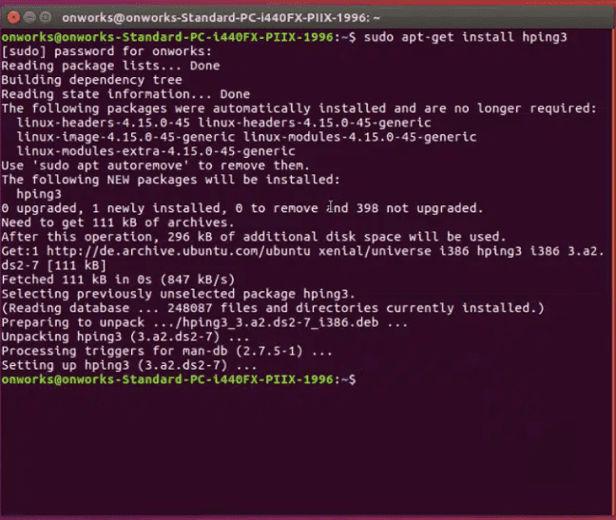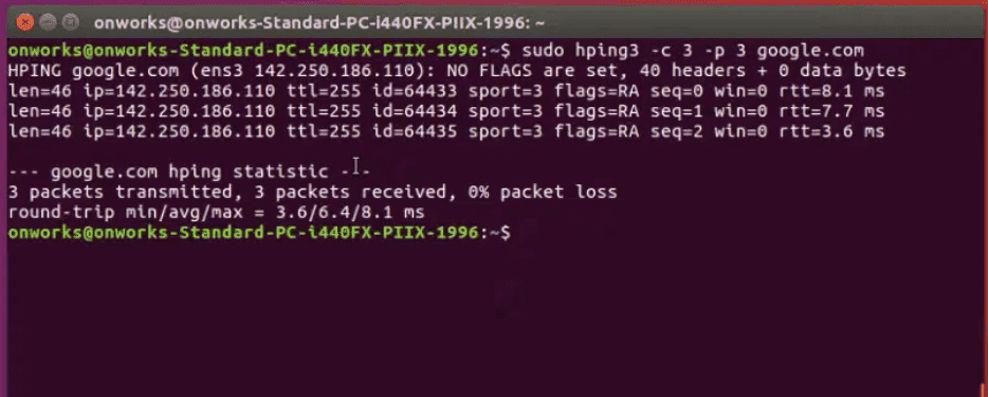hping3 Command in Linux
Last Updated :
04 Nov, 2023
Hello there, fellow tech enthusiasts! Today, we’re going to delve into the world of network manipulation using the powerful hping3 command in Linux. Whether you’re a seasoned network administrator or just curious about how networking works, hping3 is a tool you’ll want to add to your toolkit. In this article, we’ll explore what hping3 is, its capabilities, and how to use it effectively.
What is hping3?
hping3 is a command-line utility for crafting and sending custom TCP/IP packets. It is a versatile tool that allows you to perform various tasks, such as network scanning, fingerprinting, and testing network security. With hping3, you can simulate different types of network traffic, making it a valuable tool for network testing and troubleshooting.
Installation Methods for Different Linux Distributions:
Before we start exploring hping3, let’s ensure you have it installed on your Linux system. Installation methods can vary depending on your distribution.
Debian/Ubuntu:
On Debian-based systems like Ubuntu, you can use the following command to install hping3:
sudo apt-get install hping3
Red Hat/CentOS:
For Red Hat-based systems like CentOS, you can install hping3 using the following command:
sudo yum install hping3
Arch Linux:
If you’re using Arch Linux, you can install hping3 from the Arch User Repository (AUR) using an AUR helper like yay:
yay -S hping
Now that you have hping3 installed let’s delve into its usage in detail.
Output:

Basic Usage: Sending Custom Packets
Alright, let’s get into the nitty-gritty of hping3 and learn how to send custom packets. Think of it like sending special messages over the internet to check if someone’s listening. Here’s how you do it:
Imagine you want to talk to Google’s web server but not just by visiting a website; you want to send it a message. Here’s how you’d do it:
sudo hping3 -c 3 -p 80 google.com
Let’s break this down:
- “sudo”: This is like putting on your super admin hat. It gives you the power to do special things with your computer.
- “hping3”: This is the magic word that tells your computer to send special messages.
- “-c 3”: This part says you want to send three messages. Why three? Well, it’s like saying “Hello” three times to make sure Google hears you.
- “-p 80”: Now, here’s the interesting part. This says you want to send your message to port 80. In internet terms, that’s like sending a message to a specific door where web stuff usually comes in.
- “google.com”: This is your destination. It’s like writing the recipient’s address on your letter.
When you hit enter, your computer will send three special messages (ICMP echo request packets) to Google’s web server, asking it to respond. If everything goes well, you’ll get responses, and hping3 will tell you how fast the messages went and if any got lost.
So, in plain English, hping3 helps you chat with other computers on the internet and see if they’re up and running. You can use this to check if websites are alive, test network connections.
Output:

Advanced Techniques:
hping3 becomes even more powerful when you start exploring its advanced options. You can use it for tasks like:
- Firewall Testing: hping3 can be used to test the resilience of your firewall rules by sending packets with various TCP flags and options.
- Tracerouting: You can use hping3 to trace the path taken by packets to reach their destination.
- Traffic Generation: It can generate network traffic patterns to simulate different types of attacks or load on a network.
- Packet Crafting: Craft custom packets to test how your network devices and applications handle them.
- Fingerprinting: Identify the operating system or device type of a remote host by analyzing its response to crafted packets.
Safety Precautions:
While hping3 is a valuable tool, it can be misused. Always use it responsibly and with permission. Unauthorized or malicious use can harm networks and systems. Ensure you have the necessary permissions before conducting any network tests.
Conclusion:
In this article, we’ve scratched the surface of what hping3 can do on a Linux system. It’s a versatile and powerful tool for network testing, troubleshooting, and security assessment. As you explore its capabilities further, remember to use it responsibly and ethically. Happy networking, and may your packets always reach their destination!
Share your thoughts in the comments
Please Login to comment...